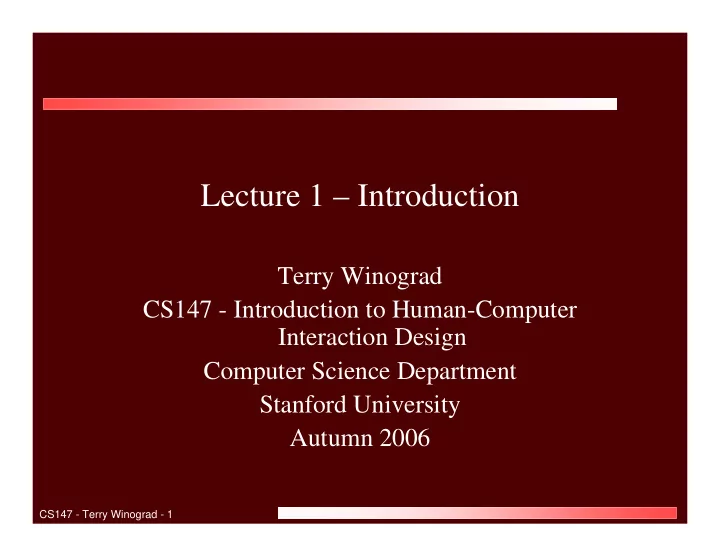

Lecture 1 – Introduction Terry Winograd CS147 - Introduction to Human-Computer Interaction Design Computer Science Department Stanford University Autumn 2006 CS147 - Terry Winograd - 1
Goals for the Course Students will learn the fundamental concepts of human-computer interaction and user-centered design thinking, through working in teams on an interaction design project, supported by lectures, readings, and discussions. They will learn to evaluate and design useable and appropriate software based on psychological, social, and technical analysis. They will become familiar with the variety of design and evaluation methods used in interaction design, and will get experience with these methods in their projects. CS147 - Terry Winograd - 2
Learning Goals for Today • Become aware of the breadth of technologies and issues in HCI today • Have a basic understanding of what interaction designers do • Learn what will happen in this course CS147 - Terry Winograd - 3
How Do People Interact with Computers? login as: winograd winograd@graphics's password: Last login: Tue Sep 20 15:22:48 2005 from xtz.stanford.edu *********************** * Welcome to SULinux! * * Authorized Use Only * *********************** Hint: run /usr/sbin/sulinux to reconfigure at any time Graphics> echo "hello world" hello world Graphics> connect to the web connect: Command not found. Graphics> help help: Command not found. Graphics> rm –R * Graphics> CS147 - Terry Winograd - 4
Desktop GUIs and Applications
Pointing Devices
Desktop GUIS and applications
Web Applications CS147 - Terry Winograd - 8
3D Desktops CS147 - Terry Winograd - 9
Mobile Devices CS147 - Terry Winograd - 10
Pen-based Interaction CS147 - Terry Winograd - 11
Interactive Workspaces CS147 - Terry Winograd - 12
Display Walls CS147 - Terry Winograd - 13
The Office of the Future CS147 - Terry Winograd - 14
Tabletop interaction CS147 - Terry Winograd - 15
Tangible Interaction CS147 - Terry Winograd - 16
Augmented Reality Tangible Media Group John Underkoffler Mit Media Lab CS147 - Terry Winograd - 17
Wearable Computers CS147 - Terry Winograd - 18
Ambient Information CS147 - Terry Winograd - 19
Voice and Multimodal Interaction CS147 - Terry Winograd - 20
Embodied Interaction CS147 - Terry Winograd - 21
Virtual Reality CS147 - Terry Winograd - 22
Sensor Networks CS147 - Terry Winograd - 23
Sensing Affect Blood Volume Pressure (BVP) earring Galvanic Skin Response (GSR) rings and bracelet CS147 - Terry Winograd - 24
STELARC Cyborgs CS147 - Terry Winograd - 25
Interaction design profession(s) • Broad set of disciplines, technical, social, business, ... • Interaction design job categories – interaction designer – usability engineer – web designer – information architect – user-experience designer – product manager – … CS147 - Terry Winograd - 26
What skills are used in HCI? • Designer – Visual and audio design – Design process skills and methods • Programmer – Systems, toolkits, and languages – Software engineering techniques • Researcher – Cognitive principles and theories – Experimental techniques CS147 - Terry Winograd - 27
Some Specific Learning Goals • Broad familiarity with the major areas of current HCI development and research • Skill with designing a GUI interface • Learn to use a variety of interaction design processes and techniques and know when they are appropriate. • Learn to evaluate an interactive product and explain what is good and bad about it in terms of the concepts, goals, and principles of interaction design. • Learn how to apply usability evaluation methods and know when they are appropriate • Understand how the diversity of users/market segments, etc. guides and constrains design • Understand the role of social dynamics in interaction and how it applies in design, including concerns such as privacy, power, and accessibility. • Be familiar with different interaction styles and their pros and cons • Be able to use metaphors appropriately in building conceptual models. • Understand cognitive factors that affect usability • Be able to judge the availability and feasibility of different devices for interacting • Have experience with ovserving users and analyzing the problems CS147 - Terry Winograd - 28
Structure of the Course [See syllabus] • Lectures • Readings – Interaction Design , Preece, Rogers, and Sharp – Readings to be provided on line • Weekly sections or team 1-on-1 with TAs – Monzy, Doantam, Kevin and Nundu • Individual assignments and 2/3-term exam • Team Project – Milestones and Presentations CS147 - Terry Winograd - 29
Other info • This course http://cs147.stanford.edu • CS547 Speakers Fridays 12:30, Gates B01 http://hci.stanford.edu/seminar Also available on line • List of all HCI courses http://hci.stanford.edu/academics/ • HCI program in general http://hci.stanford.edu CS147 - Terry Winograd - 30
Recommend
More recommend